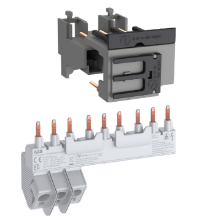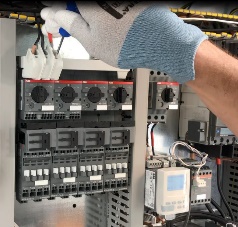
A motor is securely started and stopped using an electrical device known as a motor starter. Similar to a relay, a motor starter turns the power ON and OFF however, also provides overcurrent protection.
Key features of a motor starter:
- Starts motor safely
- Stops motor safely
- Reverse in direction
- Safeguard from overcurrent
Manual motor starters are electromechanical main circuit protection devices, also known as Motor Protection Circuit Breakers (MPCBs) or Manual Motor Protectors (MMPs). These are primarily used to manually turn motors on/off and offer fuseless protection against overload, phase failures and short circuits. In the event of a short circuit, fuseless protection can turn the motor off in milliseconds.
A motor starter is made of two main components that work together to control and protect the motor. The electrical contactor serves the purpose of a switch, to control the power supply to the motor by making or breaking the contact terminals. The purpose of the overload protection circuit is to protect the motor from potential harm due to the overload condition. A large current through the motor may damage the winding as well as other appliances connected to the supply.
Why choose ABB’s Manual Motor Starters?
ABB’s manual motor starters offer a complete motor protection solution. Starter combinations are offered with screw or push-in spring terminals, set up in conjunction with contactors.
The harmonised main accessory range (auxiliary contacts, signal contacts, shunt trips, undervoltage releases) and its compact design has been manufactured in a way that constitutes efficient planning and installation. This matches the ABB contactor family makes it a hassle-free start-up solution.
In addition, it comes with simple connecting links to ensure electrical and mechanical connection, to build direct-on-line starters. The protecting motors allow for reduced machine downtime, troubleshooting and maintenance expenditures.
Furthermore, it embodies features including adjustable current settings for overload protection, magnetic trip indication, disconnection function, temperature compensation, remote control via undervoltage release or shunt trip and short-circuit service breaking capacity is up to 100 kA.
Push-in Spring Terminals from ABB provide distinctive, quick, simple, and dependable connections.
With the brand-new comprehensive Push-in Spring motor starting solution, all it takes is one push to complete the extremely quick wiring. When compared to typical spring solutions, Push-in Spring requires no tools, reducing wiring time by up to 50%, offering speed, easiness and reliability.
Faster than ever installation
 2-in-1 connection
2-in-1 connection
ABB's 2-in-1 connection makes it possible to employ rigid and ferruled cables (Push-in mode) or cables without ferrules (Spring mode) in the same terminal for the first time. Cables can be entered in Push-in mode by simply pushing them in with your hand.
 Smart accessories
Smart accessories
Busbars and connection kits that require no tools, considerably speed up installation.
Total solution
 High connection capacities up to 18.5 kW 400 V AC-3 and 50 A AC-1 are suitable for motor starting solutions (25 hp 480 V and 45 A general use). This also offers 100 kA of short-circuit fuseless protection. Push-in Spring attachments can also be fitted on the manual motor starters and contactors' regular screw range.
High connection capacities up to 18.5 kW 400 V AC-3 and 50 A AC-1 are suitable for motor starting solutions (25 hp 480 V and 45 A general use). This also offers 100 kA of short-circuit fuseless protection. Push-in Spring attachments can also be fitted on the manual motor starters and contactors' regular screw range.
Easier than ever wiring
Intuitive wiring
All cables, busbars and connecting links with Push-in Spring have the same round form entry and the square terminals are prominently designated with screwdriver symbols. This means repeatable wiring and de-wiring that requires little to no training, free of cable errors.
There is only one screwdriver needed.
One screwdriver size will work for the whole range when de-wiring. There is also no twisting or turning necessary, reducing the risk of harm to the terminals and the overall integrity of your system.
Automated wiring
All terminals of the Push-in Spring motor starting solution allow for 90° cable insertion. Front access to terminals facilitates secure wire insertion and allows for automated robot wiring.
Robust electrical contact
Excellent electrical contact is guaranteed by the unique spring construction. You can have total confidence because of the design's strict regulation of contact strength that is independent of the operator.
Vibration-proof
Push-in Spring connections are reliable, even in hostile settings. The shock and vibration resistance of Push-in Spring technology has been examined in accordance with IEC 60068-2-27 and IEC 60068-2-6 standards.
No need to re-tighten
Self-tightening terminals eliminate the need for retightening after transit or during the product's life. The device's entire lifetime is assured to have a high-strength connection.
Push-in mode
No tools are required to connect ferruled or stiff cables; simply put the cables into the cable holes. When compared to traditional spring systems, push-in mode reduces wiring time by up to 50% and simplifies installation. Benefit from self-tightening terminals, straightforward wiring, and a decreased risk of wiring mistakes.
Spring Mode
Small cable cross-sections or cables without ferrules are suitable applications for this mode. The solution is also de-wired using it. Simply insert a screwdriver into the holes that are marked to open the terminal before installing the cable. Since no twisting or turning is necessary when using ABB's Spring mode, it is simpler to use than conventional spring technology and less likely to damage terminals.
ABB’s motor starting solution with Push-in Spring Terminals has variety of advantages as summarised below.
- Easy and fast wiring
- Tool-less and one hand mounting
- Vibration and shock proof
- Greater uptime due to robust design
- Connection technology that caters to the future
- Front-accessible terminals
- Push-in / Spring, 2-in-1 terminals
- Higher connection capacity
- Starter mounting plate not necessary
- Enabled for automated wiring
If you want to know more about IPD’s motor starting solution with Push-in Spring Terminals, we have a dedicated customer service team to help you with all your clarifications. Please contact us by clicking here.